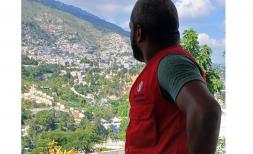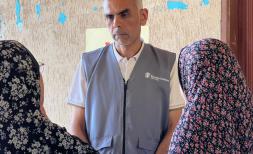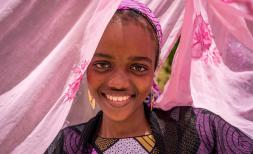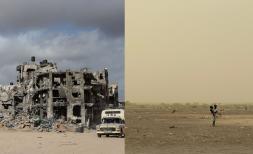It’s not too late for the great reset: priorities for global action at this week’s IMF/World Bank Spring Meetings
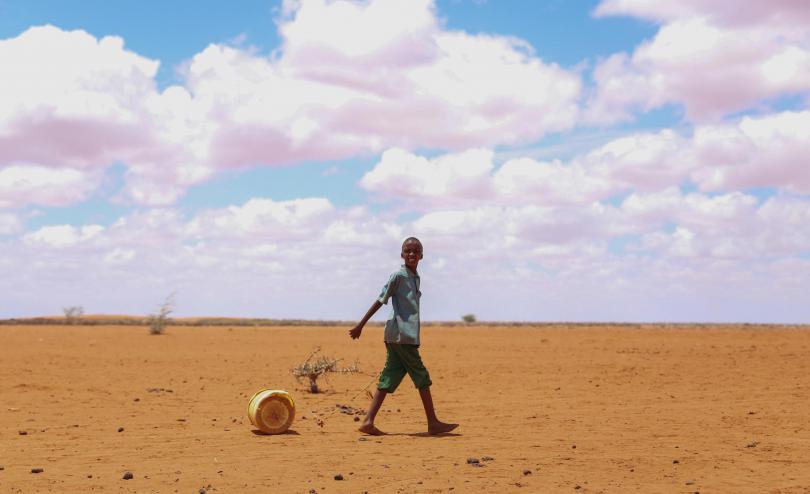
In the early days of the COVID-19 pandemic, as we all worried about what this new disease could mean for us and our families and our way of life, political and business leaders the world over made lofty promises about turning this crisis into an opportunity for a reset. ‘Build Back Better’ became the mantra on everyone’s lips. With talk of a fairer, greener world.
Two years on, the world has changed, and we’ve changed with it. In small and big ways. I never imagined I’d happily do a ‘drive through COVID test’ - with a complete stranger inserting a plastic stick up my nose and texting me the result a couple of hours later. Hopefully we’ve all come to accept that our planet is fundamentally interconnected, whether we like it or not.
Yet in many ways, the world hasn’t changed. Especially when it comes to inequality.
I have the privilege of living in the UK where everyone has access to COVID tests, vaccines and treatment – and until now all of this has been free. Whilst the UK debates how far to roll out a 4th dose, the vast majority of people in low-income countries still haven’t had any COVID vaccines. Even in the UK, COVID has hit the most vulnerable much harder. Mortality rates in the most deprived areas were more than double the least deprived areas.[1] The economic impact of COVID-19 also fell disproportionately on families already struggling, in deprived areas and on those countries least able to mobilise the financial firepower to cope.
This was before the horrors of the invasion of Ukraine.
One of the many great things about my job as Chief Executive of Save the Children UK is that I get to work with children and young people a lot. Children are often amongst the most vulnerable to shocks. Looking ahead, the triple threats of COVID, conflict and climate change could jeopardise all the positive progress that we’ve seen in the 25 years I’ve been working in international development. That progress has been phenomenal, despite what some cynics like to claim. We should be very worried.
Yet what I love about working with children and young people is that they don’t give up. They can’t: it’s their future at stake. They bring their energy, creativity and insights and demand solutions. Those who call themselves leaders need to show they can do the same.
As global decision makers head to Washington DC for the International Monetary Fund (IMF)/ World Bank Spring Meetings this week, Save the Children is calling for action in four key areas where progress is absolutely possible:
Firstly, don’t give up on the vision of a fairer, greener future: double down on it. The world’s children – particularly those in low- and middle-income countries and those experiencing inequality and discrimination – have contributed the least to the climate emergency but have the most to lose if this crisis continues unabated.[2]
Climate related shocks are already affecting all aspects of children’s lives, including disrupting the education of 37 million pupils each year and contributing to rising poverty and hunger. This will only worsen as future generations inherit a crisis that is not of their making.
Urgent and ambitious financial action is needed. High-income countries in particular, who have a unique responsibility for the problem, must fulfil their financial pledges to low- and middle-income countries who have contributed far less, but who are now suffering the consequences.
This includes increasing climate financing to go far beyond fulfilling the unmet pledge to mobilise at least $100 billion annually by 2023, and towards the trillions needed. It also includes allocating at least 50% of investment in adaptation, resilience and disaster risk reduction measures; and creating a new climate finance mechanism to address rapidly escalating loss and damage by 2023. Increases in climate finance should be accompanied by assessments, that examine the implications for different groups of children.
Secondly, develop smart ways of helping vulnerable families to cope with crises. As well as innovative disaster risk tools, social protection systems are a tried and tested way to provide a safety net, which can be scaled up quickly when crises hit. The best systems are also designed to be ‘child sensitive’.
Child poverty has a catastrophic impact on children. It not only hurts that child today, but it also stops them achieving their future potential. If we turn this vicious cycle into a virtuous circle the result is transformational: a child who achieves their full potential will in turn be able to support their own future children to do so, contributing to the human capital and economic growth of their country.
Social protection is globally recognised as an effective tool for alleviating poverty, enhancing household income security and resilience.
This is particularly true when social protection has universal coverage, through schemes such as Universal Child Benefits. Universal coverage prevents vulnerable children from falling through gaps in the system, whether girls, the very poorest, children with disabilities, or other minority groups. Evidence shows that universal benefits achieve a better return on investment than targeted social protection for children.[3]
Thirdly, we need action – and fast - to respond to the escalating hunger crisis and to prevent increased or more extreme hunger. Even before the COVID-19 pandemic, hunger levels were at a record high globally, and are now increasing to levels not seen before this century. The UN has warned that we could see ‘famines of biblical proportions’. We cannot accept this.
The solidarity and support being shown to families in Ukraine or forced to flee cannot be at the expense of equally deserving children dying of hunger elsewhere. Will the international response to Somalia this year be a repeat of the devastation in 2011 when support came too late, or the concerted action taken in 2017? With 350,000 children’s lives on the line, will donor Governments continue to argue they can’t afford to act?[4]
Even where hunger doesn’t kill a child, it can leave lifelong scars. Without enough to eat and the right nutritional balance, children cannot develop as they should, and are at high risk of acute malnutrition. It can impact their access to education as families attempt to manage costs, and lead to increases in child marriage and child labour.
Of course, we need to tackle the underlying causes of the hunger crisis, from resolving political conflicts to sustainable agriculture. But children hungry today can’t wait.
Fourthly and lastly, we need to ensure finance is invested wisely. The World Bank and the IMF have a vital role to play in helping low- and middle-income countries to cope with the massive financial shocks they continue to face, and to compensate for their lack of access to other sources of funds.
Interest rate rises and exchange rate shifts are exacerbating the debt crisis. The World Bank and the IMF should work with the G20 to strengthen debt relief for low- and middle-income countries under the G20 Common Framework, including by ensuring the stronger integration of private creditors and enforcing their contribution as stipulated under the Framework. Preliminary assessments of debt relief needed within the Common Framework for each country eligible should also be undertaken, to enhance transparency and accountability.
Whilst the $650 billion allocation of IMF Special Drawing Rights was widely welcomed when it came into effect last year, it is crucial that the assets are reallocated to low- and middle-income countries that need them most to support them to combat the crises many countries are currently facing.
We still have a window to act, to build that better future. I look forward to seeing the World Bank, IMF, Governments, and other actors at the global level come together and grip this challenge, for the sake of the next generation. As we say at Save the Children: we’re in the business of ‘powering possible’. Join us.
[1] Office for National Statistics (2020). Deaths involving COVID-19 by local area and socioeconomic deprivation: deaths occurring between 1 March and 31 July 2020. https://www.ons.gov.uk/peoplepopulationandcommunity/birthsdeathsandmarriages/deaths/bulletins/deathsinvolvingcovid19bylocalareasanddeprivation/deathsoccurringbetween1marchand31july2020
[2] Save the Children (2021), Born Into the Climate Crisis. https://resourcecentre.savethechildren.net/document/born-climate-crisis-why-we-must-act-now-secure-childrens-rights/?_ga=2.64395695.1218035967.1649772666-490075281.1642590766
[3] Save the Children (2020), A Foundation to End Child Poverty: How universal child benefits can build a fairer, more inclusive and resilience future. https://resourcecentre.savethechildren.net/document/foundation-end-child-poverty-how-universal-child-benefits-can-build-fairer-more-inclusive/
[4] BBC, 2022. Somalia Drought: Act now or 350,000 children will die https://www.bbc.co.uk/news/world-africa-61036465
